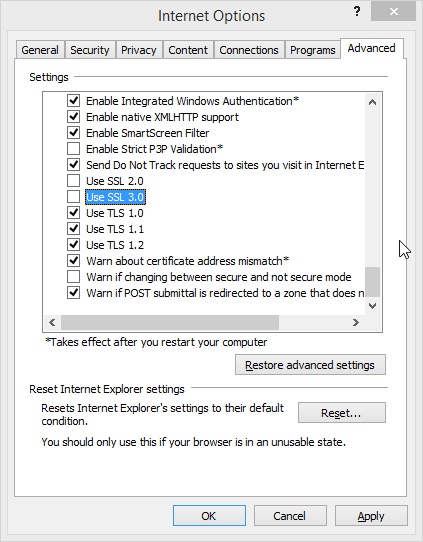Securing your browsers: Internet Explorer
Tue-2015-01-06 Leave a comment
As third and last, I’ll show you how to secure your browser settings for Internet Explorer.
Internet Explorer is somewhat different because it doesn’t have it’s own settings for cipher suites. It gets those from the operating system. In Windows they are implemented in one of the SSPI’s namely SChannel. So to enable or disable cipher suites in IE, you need to enable or disable them in Windows.
First, let’s take care of the obvious. In IE there is an SSLv3 setting in the Advanced tab of the Internet Options. Uncheck this and IE will be POODLE-proof. SSL 2.0 should be unchecked by default.
Now, to disable cipher suites we could edit the registry. This is complicated and error prone, so we are going to use a tool. Download IIS Crypto here. I recommend version 1.6 GUI for .NET 4.0.
Start the tool with elevated privileges and have most of the work done for you by clicking the Best Practices button. You’ll have to Press the Apply button and restart for the changes to take effect.
I have edited the cipher suite order and put the ECDHE_ECDSA ciphers at the top of the list, followed by the ECDHE_RSA ciphers. I have tried disabling MD5 hashing but found that some applications for RDP were not working anymore. Disable every protocol before TLS 1.0 and every cipher suite above Triple DES 168. I tried disabling Triple DES 168, but some websites wont work anymore because they are not updated to use the newer Elliptic Curve cipher suites yet. Please test what works for you and post in comments.
As you can see, I disabled all TLS_DHE_DSS suites and the RC4 suite. I use the 3DES_CBC suite as a fallback suite.
I also disabled a few RSA SHA256 and RSA SHA384 suites because Microsoft released a bad patch. The IIS Crypto site also tells us to disable these:
This concludes my ‘series’ on how to secure your browser. It may be that these settings will be deprecated real soon. It might also be that you can use these safely for a few years. All depends on the progress and development in the field of cryptography. I will keep you updated.




